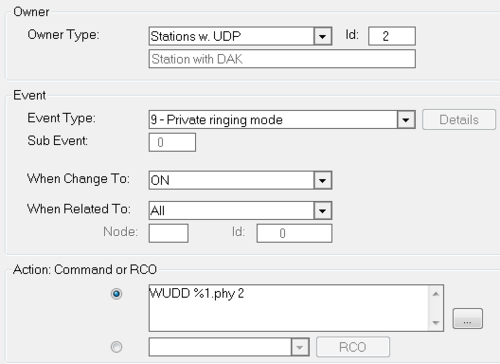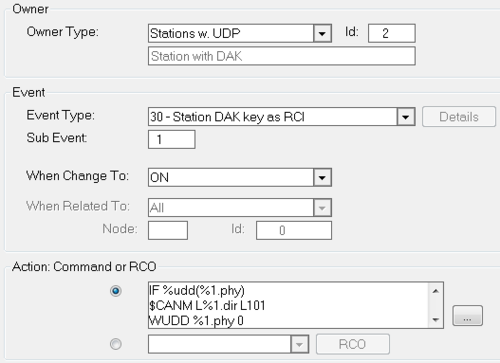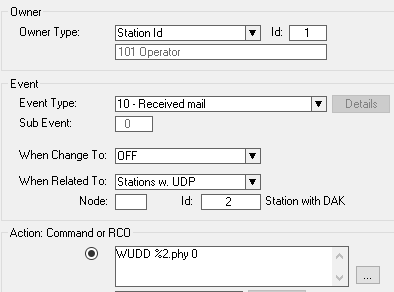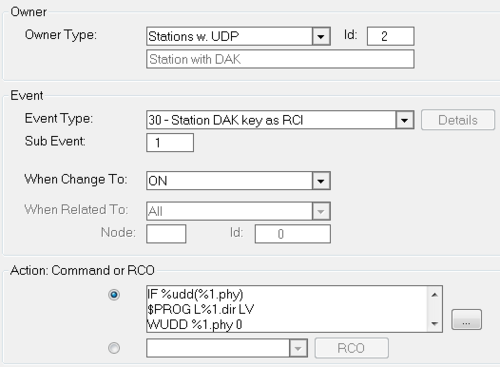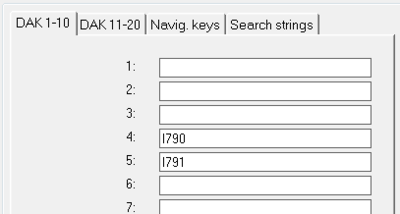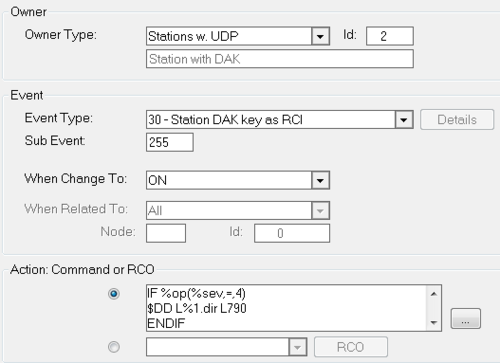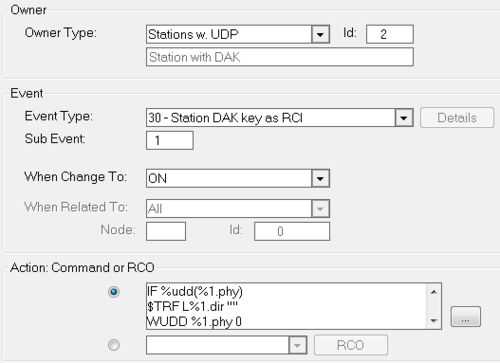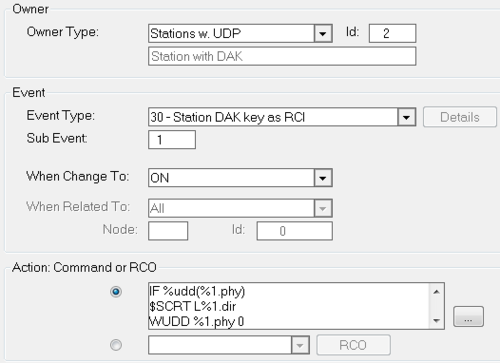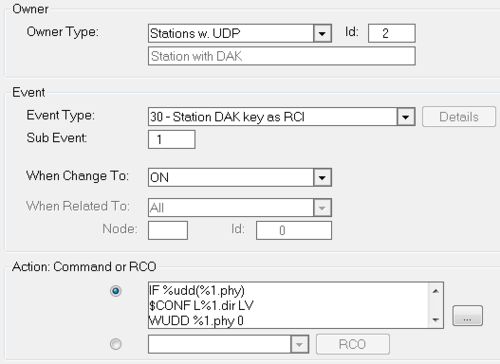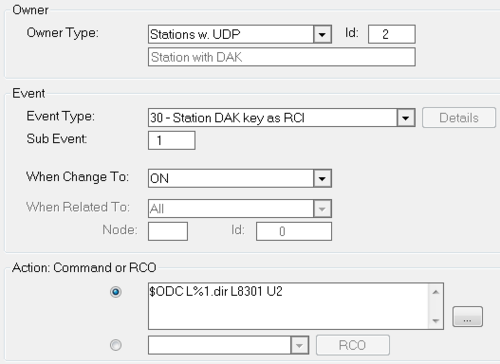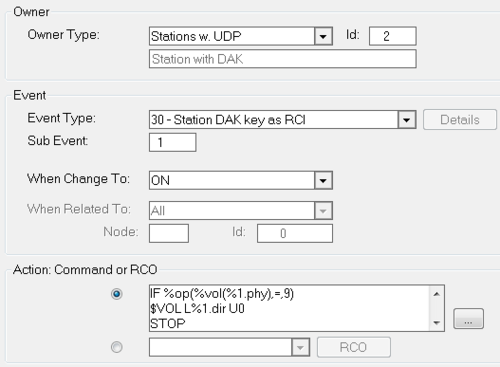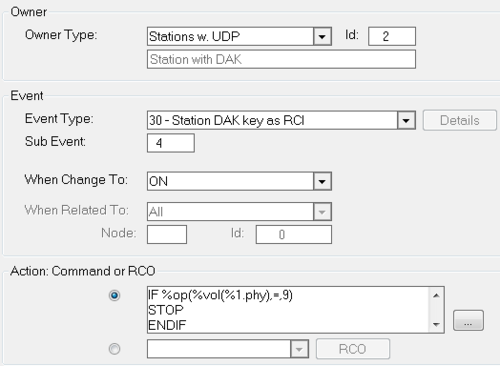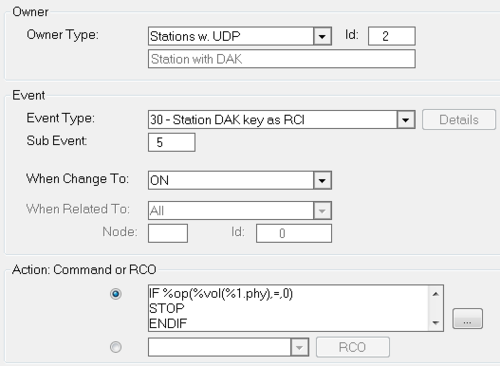Toggle Applications: Difference between revisions
From Zenitel Wiki
| Line 165: | Line 165: | ||
==Simplex Conference== | ==Simplex Conference== | ||
Toggle between joining a simplex conference (SX), and leaving it. The example shows joining/leaving SX1 (8201). | Toggle between '''joining''' a '''simplex conference (SX)''', and '''leaving''' it. The example shows joining/leaving SX1 (8201). | ||
[[File:Toggle Applications 5.PNG|thumb|left|500px|First press: Join Simplex Conference 1 (8201) <br> Second press: Leave the Simplex Conference]] | [[File:Toggle Applications 5.PNG|thumb|left|500px|First press: Join Simplex Conference 1 (8201) <br> Second press: Leave the Simplex Conference]] | ||
| Line 171: | Line 171: | ||
Action commands: | Action commands: | ||
IF %udd(%1.phy) | ''IF %udd(%1.phy)'' | ||
$CONF L%1.dir LV | ''$CONF L%1.dir LV'' | ||
WUDD %1.phy 0 | ''WUDD %1.phy 0'' | ||
STOP | ''STOP'' | ||
ENDIF | ''ENDIF'' | ||
$CONF L%1.dir L8201 | ''$CONF L%1.dir L8201'' | ||
WUDD %1.phy 1 | ''WUDD %1.phy 1'' | ||
<br/> | |||
For more details see [[$CONF]] | For more details see [[$CONF]] | ||
Revision as of 07:32, 14 August 2018
This article describes different applications where the common scenario is to toggle a feature on/off using just a DAK key (or station input). Some features have options that gives additional opportunities.
In the examples below the AlphaCom data commands used are hyperlinked. Common for many of them is:
The DAK as RCI event is the preferred event for most of the applications.
Conversation
Toggle between Call and Cancel: pressing DAK key 1 sets up a call to station 101. Second press cancels the call. A second event must be created to handle the scenario where 101 initiates the call , or ends the call.
Action commands:
IF %udd(%1.phy) $C L%1.dir WUDD %1.phy 0 STOP ENDIF $CALL L%1.dir L101 WUDD %1.phy 1
Action command:
WUDD %1.phy %chg(1,0)
The same DAK can also answer an incoming call in private mode. Then the following event must be added:
Add some commands to the top of the initial DAK as RCI event, making it look like this:
IF %op(%udd(%1.phy),=,2) $M L%1.dir pause $MREL L%1.dir WUDD %1.phy 1 STOP ENDIF IF %udd(%1.phy) $C L%1.dir WUDD %1.phy 0 STOP ENDIF $CALL L%1.dir L101 WUDD %1.phy 1
For more details see $CALL, $C, $M, $MREL and pause
Call Request
Toggle between Call Request and Cancel Call Request: Pressing the DAK key the first time sends a Call Request to station 101 in the example. Second press cancels the call request. A second event must be created to handle the scenario where 101 answers the call request, or cancels it.
Action commands:
IF %udd(%1.phy) $CANM L%1.dir L101 WUDD %1.phy 0 STOP ENDIF $SM L%1.dir L101 WUDD %1.phy 1
Action commands:
WUDD %2.phy 0
To add the possibility to answer incoming calls in private using the same DAK, see the Conversation application example.
For more details see $CANM, $SM and Call Request
Audio Program
Toggle between Program ON and Program OFF. The example shows program 1 (801).
Action commands:
IF %udd(%1.phy) $PROG L%1.dir LV WUDD %1.phy 0 STOP ENDIF $PROG L%1.dir L801 WUDD %1.phy 1
Stepping through several programs can be performed by using the step codes 790 and 791 configured in the DAK settings:
An event can also be created to do this. The example below uses DAK 4 for stepping to next program, and DAK 5 for stepping to previous program.
Action commands:
IF %op(%sev,=,4) $DD L%1.dir L790 ENDIF IF %op(%sev,=,5) $DD L%1.dir L791 ENDIF
For more details see $PROG and Audio Program
Transfer
Toggle between Transfer ON and Transfer OFF. The example shows transferring calls to directory number 101.
Action commands:
IF %udd(%1.phy) $TRF L%1.dir "" WUDD %1.phy 0 STOP ENDIF $TRF L%1.dir L101 WUDD %1.phy 1
Toggle between Call Request Transfer ON and Call Request transfer OFF. The example shows transferring Call Requests to directory number 101.
Action commands:
IF %udd(%1.phy) $SCRT L%1.dir WUDD %1.phy 0 STOP ENDIF $SCRT L%1.dir L101 WUDD %1.phy 1
Option: If using a station with LED indications on the DAK keys (i.e. CRM-V or ECPIR-3P) the LED can be switched on and off to show status of the transfer. Change the action commands for the transfer event like this: (example shows red LED)
IF %udd(%1.phy) $TRF L%1.dir "" WUDD %1.phy 0 IND %1.phy %1.dir(i%2.dir) 1 1 OFF STOP ENDIF $TRF L%1.dir L101 WUDD %1.phy 1 IND %1.phy %1.dir(i%2.dir) 1 1 ON
For more details see $TRF, $SCRT and IND
Simplex Conference
Toggle between joining a simplex conference (SX), and leaving it. The example shows joining/leaving SX1 (8201).
Action commands:
IF %udd(%1.phy) $CONF L%1.dir LV WUDD %1.phy 0 STOP ENDIF $CONF L%1.dir L8201 WUDD %1.phy 1
For more details see $CONF
Open Duplex Conference
Toggle between joining a open duplex conference (ODC), and leaving it. The example shows joining/leaving ODC1 (8301).
Action command:
$ODC L%1.dir L8301 U2
For more details see $ODC
Volume adjustment
Stepping the volume in a circle using just one button. After max volume, the next step is minimum volume.
Action commands:
IF %op(%vol(%1.phy),=,9) $VOL L%1.dir U0 STOP ENDIF $VOL L%1.dir U%op(%vol(%1.phy),+,1)
Alternatively the volume stepping can be in double rate, incrementing the volume by two for each button press:
Action commands:
IF %op(%vol(%1.phy),=,9) $VOL L%1.dir U1 STOP ENDIF $VOL L%1.dir U%op(%vol(%1.phy),+,2)
Using a station with two buttons (or two inputs) assigning one for volume up, and one for volume down:
Action commands:
IF %op(%vol(%1.phy),=,9) STOP ENDIF $VOL L%1.dir U%op(%vol(%1.phy),+,1)
Action commands:
IF %op(%vol(%1.phy),=,0) STOP ENDIF $VOL L%1.dir U%op(%vol(%1.phy),-,1)
For more details see VOL



